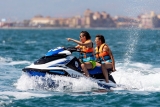
The saying "each to their own" makes more sense than ever when it comes to choosing the best diving suit. Every diver prefers one model over another depending on how sensitive you are to cold, how comfortable you feel, or whether it’s more or less fashionable...
But above all, it’s important to remember that a diving suit should minimise the risks involved in practising our favourite water sport, whether it’s potential scratches, loss of body heat, or stings from marine species.
For those unsure about which type of diving suit to buy, here we outline the main features of each so you can decide which best suits the type of dives you usually do.
2. Semi-Dry Diving Suit
3. Wetsuit
1. Dry Diving Suit

- The key feature of these suits is that they guarantee complete waterproofing. Your body will never come into contact with the water.
- They are typically made from neoprene, allowing you to wear minimal clothing while keeping your body heat intact.
- Perfect for diving in very cold waters or for long-duration dives.
- Being completely airtight "requires" valves in its design to insert air inside.
- Their construction makes the suit less form-fitting than other models.
- Using a dry suit for diving requires more experience than other types, especially due to buoyancy changes caused by the air inside and its compression/expansion during descent or ascent.
- To use it correctly, a specific course is recommended to teach proper maintenance. Even so, its durability is lower than other models.
- Its price is significantly higher.
2. Semi-Dry Diving Suit

- This diving suit is the preferred choice for most as it’s the most versatile. It can be used in winter and summer, and no prior knowledge is needed.
- Recommended for diving in temperatures between 10-25°C.
- Ideal for recreational diving due to its thermal comfort and waterproofing.
- Made from neoprene.
- The seals at the ankles, wrists, and neck prevent (or nearly prevent) water ingress, saving energy during the dive.
- They retain heat throughout the dive.
- You’ll need help to zip up the suit, as the seals are designed for maximum waterproofing, and the zip is placed at the back to avoid snagging on equipment.
3. Wetsuit

- Wetsuits are designed for dives in warm waters or summer conditions.
- Body heat is maintained by the thermal barrier created between the skin and the suit, as the neoprene traps a thin layer of water.
- The neoprene in these suits contains large, uniform bubbles for insulation.
- Thickness is crucial—ranging from 1mm to 9mm, depending on water temperature.
- A wetsuit should fit snugly but not tightly, so take your time trying on several and seek expert advice.
- There are three types: shorties (short sleeves/knee-length), full-body (covering limbs), and two-piece (usable as double insulation or separately).

If you’re buying a technical diving suit, it’s likely because you’re not an occasional hobbyist and know exactly where you want to dive with full confidence. Even so, always consult dive shops or schools for advice on the best options for your specific needs.
Here you’ll find the UK’s top diving professionals. Dive packages, schools, and all kinds of diving courses for those who won’t settle for just any adventure. Go get yours! In this case, we know it’s waiting in the sea...











